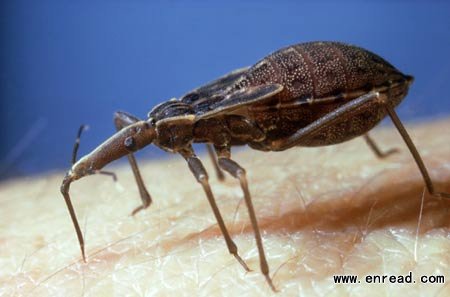美洲发现新式寄生虫传染病
A parasitic infection called Chagas Disease has similarities to the early spread of HIV, according to research published recently in the journal PLoS Neglected Tropical Diseases.
根据《PLoS被忽视的热带疾病》期刊近日发布的研究称,这种名为“查加斯病”的寄生虫传染疾病和艾滋病早期的传播过程具有相似性。

Chagas disease is a parasitic infection transmitted by blood-sucking insects, largely in impovershed areas.
Like AIDS, Chagas is hard to detect and has a long incubation period(孵育期) before symptoms emerge, the study said, according to the New York Times.
As many as 8 million people are infected in the Western Hemisphere, mainly in Bolivia, Mexico, Colombia and Central America, as well as some 30,000 people in the US, the newspaper reported. Chagas infects people in areas of poverty, and most US cases are found in immigrants.
Because Chagas is often left untreated, it spreads easily, either genetically or through blood transfusion(输血) . If caught early, it can be treated with intense medication, but the drugs are scarce in poor countries and very little money is invested in searching for new treatments, the paper said.
Chagas is usually transmitted from the bite of blood-sucking insects that release a parasite called Trypanosoma cruzi into the victim’s bloodstream. The parasite can eventually make its way to the heart, where it can live and multiply.
Infections often stay dormant for years, and then emerge as heart arrhythmias and heart failure. About a quarter of victims develop enlarged heart or intestines(肠) that can lead to sudden death if they burst, according to the Centers for Disease Control and Prevention.
New research suggests Chagas may have led to the death of Charles Darwin — one of the great medical mysteries.
Researchers from the University of Maryland School of Medicine believe Darwin suffered from three different illnesses, including a Chagas infection contracted on a voyage to the Andes in South America, the Wall Street Journal reported earlier this month.
Darwin wrote in his diary that he was bitten by a "great wingless black bug" during the trip in 1835. He died 47 years later of heart failure.